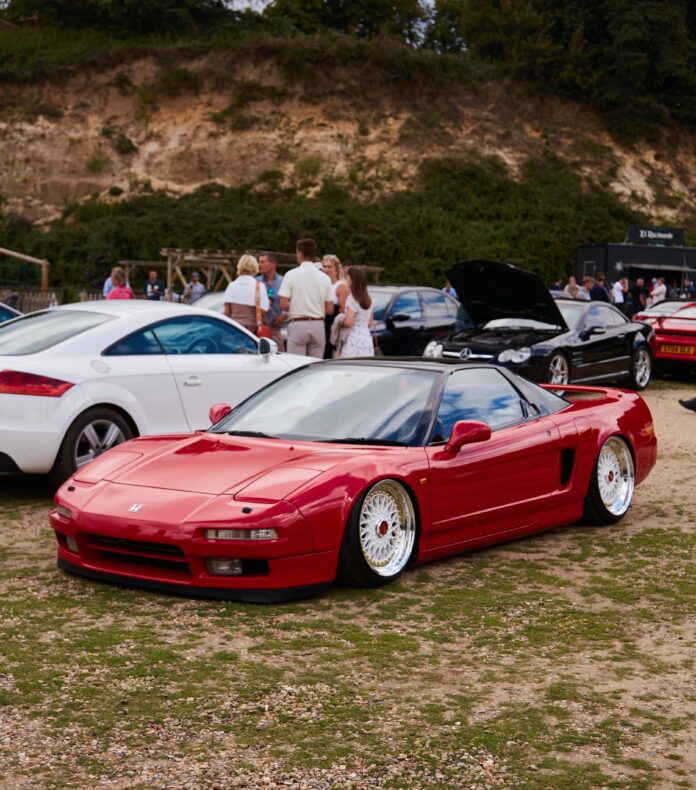Acura NSX: A Roaring Start to the Japanese Supercar Saga
Rev your engines and buckle up because we’re diving into the heart-pounding world of the Acura NSX. It wasn’t just Japan’s first supercar; it was a thunderous challenge to European dominance, redefining the very essence of automotive exotica. Forget about harsh rides, poor visibility, and the nightmares of expensive maintenance; the Acura NSX burst onto the scene with a roar that echoed through the realms of automobilia.
The Genesis: Shaping Dreams with Soichiro Honda and Pininfarina
In the neon-lit landscape of the ’80s, when sports cars weren’t living up to their sporty promises, Soichiro Honda, the visionary founder of Honda Motor Company, decided to rewrite the script. He believed Honda could craft something better than a Ferrari without breaking the bank. So, he dialed up Pininfarina, the Italian design maestros, and pitched an audacious idea—forget the conventional front engine, front-wheel-drive setup. Instead, let’s go mid-engine, rear-wheel drive. The result? The HP-X, a dazzling white doorstop with no doors, reminiscent of Maverick and Goose climbing into an F-14.

From Concept to Reality: Birth of the NSX
Amidst the Formula One fervor, Honda engineers, in their pursuit of speed, transformed ordinary cars like the Honda City and CRX into mid-engine, rear-wheel-drive test mules. Simultaneously, the Acura brand was about to debut in the U.S., and Honda saw an opportunity to crown it with a halo car. The project was dubbed NSX, standing for New Sports car eXperimental—a glimpse into the unknown world of automotive excellence.
Designing the Future: Aesthetics and Aerodynamics in Harmony
Crafting an unforgettable driving experience was at the core of NSX’s development. Drawing inspiration from F16 fighter jets, F1 cars, and hydroplane racing boats, the NSX’s design embodied the best of aerodynamics and functionality. It wasn’t just about speed; it was about 360-degree visibility, a design philosophy that carried echoes of the HP-X. The NSX was envisioned not just as a track beast but a comfortable daily driver, challenging the stereotype of supercars as garage queens.

Heart of the Beast: Engineering Marvels and VTEC Symphony
To match its European rivals, the NSX needed a powerhouse. The initial 2-liter V6 from the Acura Legend fell short, pushing Honda to blend JDM Integra’s VTEC technology with Formula One racing innovations. The result? A roaring 3-liter, all-aluminum V6 producing 270 horsepower. The engine, a marvel in itself, boasted pistons forged in the fires of Mount Doom and connecting rods made of titanium—a groundbreaking combination in production car history.
Balancing Act: Performance, Comfort, and a Lightweight Ballet
Honda aimed for F1-like handling without compromising on modern amenities like air conditioning, power windows, and ABS. The challenge was clear—maintain the NSX’s lightweight agility. The solution? Aluminum. A lot of it. Honda’s quest for lightweight strength led to the development of a unique lightweight monocoque chassis, with five carefully chosen aluminum alloys and advanced processing techniques. The result? A chassis 50% stiffer than the prototype and 40% lighter than an equivalent steel counterpart.

From Debut to Dominance: NSX Conquers Hearts and Tracks
In 1989, the NSX prototype wowed the automotive world at the Chicago International Motor Show. A hilarious mishap involving the president of Honda only added to the legend. As production kicked off in 1990, the NSX became a phenomenon. Dealers in the U.S. were keeping cars for themselves, and in Japan, a three-year waiting list emerged. The NSX was not just a car; it was a revelation. Owners were invited to track days for lessons, turning the feedback into the track-oriented 1992 NSX Type-R.
Evolution and Challenges: The NSX Legacy
As the years passed, the NSX faced challenges. Sales dwindled, leading to the introduction of the NSX-T in 1995, removing the roof but adding more weight for the sake of nostalgia. The late ’90s saw engine upgrades, and in 1999, the limited Alex Zanardi Edition NSX paid homage to the racing legend. However, despite the love, the original NSX bid farewell in 2005, leaving a void that enthusiasts would soon feel.

Revival and Reinvention: The NSX Returns
The NSX, despite its departure, left an indelible mark. In 2016, Honda, after toying with a V10 and weathering economic downturns, presented a reinvented NSX. A mid-mounted twin-turbo V6, three electric motors, and all-wheel drive combined to produce a staggering 573 horsepower. Lead designer Michelle Christensen dubbed it “an American muscle car in an Italian exotic car’s body,” marking a departure from the original NSX’s aesthetics but retaining its spirit.

Acura NSX—A Legend Reimagined
The Acura NSX is not just a car; it’s a journey. From its audacious beginnings challenging the supremacy of European giants to its evolution into a hybrid marvel, the NSX has woven itself into the fabric of automotive history. The spirit of innovation and the pursuit of driving perfection define the NSX legacy, leaving us eagerly anticipating the next chapter in this saga of speed, style, and engineering brilliance.
FAQs
1. Does the NSX live up to its legacy in terms of performance?
Absolutely. The reinvented NSX, with its hybrid powertrain, delivers Ferrari-level performance at a more accessible price point, earning accolades like Road & Track’s 2017 Performance Car of the Year.
2. How did the original NSX influence sports car design?
The original NSX challenged the notion that sports cars had to compromise on comfort. Its mid-engine layout, aerodynamic design, and focus on daily drivability set new standards, influencing subsequent generations of sports cars.
3. What led to the decline in sales of the original NSX?
Despite its acclaim, sales declined in the late ’90s, possibly due to the NSX remaining largely unchanged for 15 years. However, it left an enduring impact, and its departure sparked renewed interest in the model.
4. How did Honda overcome the challenges in developing the lightweight chassis for the NSX?
Honda’s commitment to a lightweight yet strong chassis led to the use of advanced aluminum alloys and meticulous processing techniques. The resulting monocoque chassis was 50% stiffer and 40% lighter than its steel counterpart.
5. What distinguishes the reinvented NSX from its predecessor?
The reinvented NSX, while departing from the original’s aesthetics, retains its spirit of innovation. With a mid-mounted twin-turbo V6, three electric motors, and all-wheel drive, it represents a fusion of American muscle and Italian exotic car characteristics, offering a unique driving experience.





